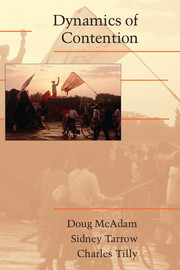Book contents
2 - LINEAMENTS OF CONTENTION
Published online by Cambridge University Press: 05 June 2012
Summary
Under what conditions will normally apathetic, frightened, or disorganized people explode into the streets, put down their tools, or mount the barricades? How do different actors and identities appear and transform in episodes of contention? Finally, what kinds of trajectories do these processes follow? As the last chapter makes clear, our ultimate interest lies not in the recruitment of static, unchanging actors into single movements, but in the dynamic processes through which new political actors, identities, and forms of action emerge, interact, coalesce and evolve during complex episodes of contention. Since the road to those processes is long and arduous, we approach it through a series of incremental steps.
In this chapter we move first, to the mobilization of people into movements; from there to the formation of collective actors and identities; and from there to the trajectories of contention in which these processes occur, deploying evidence from our three touchstone cases in the United States, France, and Italy. We first depart from the classical social movement agenda to propose a more dynamic model of the mobilization process. We then interrogate that model by showing how mechanisms attached to actors, identities, and actions intersect with mobilization. We finally examine some mechanisms associated with trajectories of contention to suggest how both mobilization and actors, identities and actions can transform in the course of episodes of contention.
- Type
- Chapter
- Information
- Dynamics of Contention , pp. 38 - 71Publisher: Cambridge University PressPrint publication year: 2001
- 1
- Cited by



